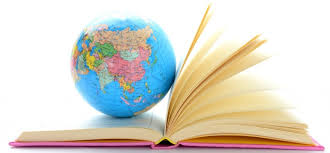What can you do to support and bring about global competence?
Get involved and collaborate with others!
Get involved and collaborate with others!

Our next event is Global Collaboration Week! Formerly known as Global Collaboration Day, we've expanded our fourth annual celebration to span an entire week. Global Collaboration Week is scheduled to take place around the same time as other global events including International Dot Day, International Day of Peace, Peace One Day, and Global Goals Week. During this week, experienced global educators and other professionals will design and host connective projects and events and invite public participation. The primary goals of this whole day event are to demonstrate the power of global connectivity in classrooms, schools, institutions of informal learning and universities around the world, and to introduce others to the tools, resources, projects, and networks that are available to educators today.
This is an opportunity for educators new to globally connected teaching and learning to participate in virtual activities designed by more experienced teachers. It's also a great way for educators running ongoing global projects to find project partners!
This is an opportunity for educators new to globally connected teaching and learning to participate in virtual activities designed by more experienced teachers. It's also a great way for educators running ongoing global projects to find project partners!
|
In General:
For Students:
|
Curriculum:
For Teachers:
|
|
CCSS.MATH.CONTENT.HSF.LE.A.1.C
Recognize situations in which a quantity grows or decays by a constant percent rate per unit interval relative to another. Students could do research on population growth rate (globally or they may choose a specific location) and investigate the effect that a related global issue such as waste, food, disease, life"expectancy/mortality rate, poverty, inflation, national debt, etc. has on population. Students can use technology resources to find accurate data points from reliable internet sources, and will use exponential regressions to make a future prediction. |
CCSS.MATH.CONTENT.HSF.LE.B.5
Interpret the parameters in a linear or exponential function in terms of a context. Exponential functions can be observed a lot in our world; the division of the cell, population growth, half-life, medication in the body, and compound interest. When students are given the chance to explore, discuss, and write exponential equations to represent these 9 situations, exponential functions become meaningful and important. |
Want to see how it's being done? Check out my lesson plan adaptions.
Where can I find resources?
|
Lesson Plans and Resources with an International Focus
*Compiled by IREX |
*Please note that IREX provides this list of websites, tools, and opportunities as a resource, but does not take responsibility for the content or accuracy of the information found on these online tools and sites.
|
United Nations |
The United Nations Cyberschoolbus, located at www.un.org/cyberschoolbus, is the UN's information center for students and teachers. Whether you are a student preparing for a Model UN conference or working on a research project, or a teacher preparing a lesson on hunger or looking for an activity on landmines, the Cyberschoolbus is likely to have something for you. |
OXFAM
|
Oxfam Education offers a huge range of ideas, resources and support for developing global learning in the classroom and the whole school. All of the resources here support Education for Global Citizenship – education that helps pupils understand their world and make a positive difference in it.
|
National Geographic EducatorNational Geographic is proud to offer a wide assortment of professional learning opportunities for educators engaging with students from pre-K to post-secondary. Our programs and resources range from in-the-field projects to digital resources to online networks to grant opportunities and courses.
|
Scholastic |
Thousands of grab-and-go lesson plans, unit plans, discussion guides, extension activities, and other teaching ideas
|
|
TeachUNICEF provides educators and youth service professionals with global learning resources for grades PreK-12: in-person workshops, school-based programming, free web-based lesson plans, videos, multi-media resources and more. The units, lesson plans, stories, videos and multimedia cover topics ranging from the Millennium Development Goals to poverty and water and sanitation |
Teach
|
Peace Corp Educator |
There are Peace Corps Volunteers in every region of the world working at the grassroots level. Their stories, projects, and experiences can provide firsthand views of cultures not usually accessible through textbooks, films, and other familiar media. Paul D. Coverdell World Wise Schools promotes the Peace Corps' Third Goal of teaching Americans about the world by providing educational resources to promote global competence.
Check out the Speakers Match! Educators submit a Request Form, including specific details of how they would like to connect to a Volunteer. Volunteers interested in participating in the activity will contact the educator directly. If you have already identified a Volunteer, enter their name and country of service in the Details about Connection box on the Request Form. |
NATIONAL SECURITY AGENCY |
Partnerships help cultivate the next generation of experts in science, technology, engineering, math, language and analysis. They broaden the pool of skilled cybersecurity professionals who can protect our nation from cyberattacks. Our academic partnerships foster interest in critical need foreign languages. They also advance science through research and innovation that benefits the country even beyond NSA's need to apply emerging technologies to our mission. |
|
The World Savvy Classrooms program integrates the highest level of global competence learning into classrooms by combining professional development and consulting for educators with project-based learning for K-12 students. The Classrooms program is aligned with and supports Common Core state standards, ensuring students learn the required ‘core’ content mandated by state and national standards, in a way that establishes real-world connections to the material.
|
|
Primary Source |
Our professional learning opportunities for K-12 educators offer new perspectives, collaborative discussions, and resources for more culturally responsive and globally inclusive teaching. We know that the key to building global proficiency and 21st-century skills in the classroom is to inspire educators, and we reach thousands every year. By helping identify entry points in the curriculum, we support teachers in seamlessly including a global approach. Since 1989, Primary Source has reached over one million students.
|
|
The Global Dimension website provides a searchable guide of over 1,000 reviewed books, films, posters and web resources which support global learning across all age groups and subjects.
|
Global Dimension |
REALWORLDMATH.ORG |
Teachers have access to lesson write ups and additional material to integrate these activities effectively. The core of the site is mathematics for grades 4 and up, but many lessons lend themselves to interdisciplinary activities. This is a modern approach to mathematics that is student-centered and task-oriented; it embraces active learning, constructivism, and project-based activities, while remaining true to the standards. Higher level thinking skills, such as analysis, synthesis, and creativity are encouraged as well as technology skills and social learning.
|
Mathalicious |
Mathalicious says their philosophy is to "create lessons that explore the math behind real-world topics" and "challenge students to construct arguments, justify their reasoning, and use mathematics to think more critically about the world."
|
|
Teacher created lessons based on travel and cultural experiences around the world. They are also provided in Spanish!
|
GLOBAL MATH STORIES |

